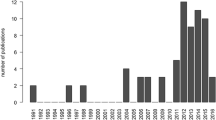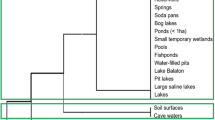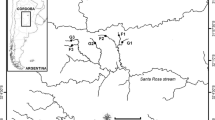Abstract
Single-trait analyses are used to select the most appropriate species characteristics for an effective indication of changes in multiple stressors, but they are robust to detect fine-scale functional changes in biofilms. The combination of single traits may appropriately reflect ecological properties of changing benthic assemblages. We studied colonisation processes of benthic algal assemblages focusing on the changes in trait composition using life forms, type of attachments, cell size and mobility as single traits in a small lowland stream. We tested the descriptive power of single-trait groups (STGs) and also combined trait groups (CTGs). We assumed that STGs would be significantly affected by environmental factors, but compositional changes in biofilms would be described more easily by using CTGs rather than STGs. Our hypotheses were confirmed by the results. While some STGs correlated positively to environmental factors indicating disturbances, others correlated to environmental factors indicating the stable conditions. The fast settlement of large-sized groups was also relevant determining the compositional changes in the studied benthic community. Despite the strong correlation between STGs and environmental variables, CTGs analyses revealed important functional relations in the ecosystem, since CTGs display more sophisticated functional features of the organisms, which may provide more realistic responses.



Similar content being viewed by others
References
Abonyi, A., M. Leitão, I. Stanković, G. Borics, G. Várbíró & J. Padisák, 2014. A large river (River Loire, France) survey to compare phytoplankton functional approaches: do they display river zones in similar ways? Ecological Indicators 46: 11–22.
Ács, É. & K. T. Kiss, 1993. Colonization process of diatoms on artificial substrate in the River Danube near Budapest (Hungary). Hydrobiologia 269(270): 307–315.
Ács, É., K. T. Kiss, K. Szabó & J. Makk, 2000. Short-term colonisation sequence of periphyton on glass slides in a large river (River Danube, near Budapest). Algological Studies 100: 135–156.
Barbiero, R. P., 2000. A multi-lake comparison of epilithic diatom communities on natural and artificial substrates. Hydrobiologia 438: 157–170.
B-Béres, V., P. Török, Z. Kókai, E. T-Krasznai, B. Tóthmérész & I. Bácsi, 2014. Ecological diatom guilds are useful but not sensitive enough as indicators of extremely changing water regimes. Hydrobiologia 738: 191–204.
B-Béres, V., Á. Lukács, P. Török, Z. Kókai, Z. Novák, E. T-Krasznai, B. Tóthmérész & I. Bácsi, 2016. Combined eco-morphological functional groups are reliable indicators of colonisation processes of benthic diatom assemblages in a lowland stream. Ecological Indicators 64: 31–38.
B-Béres, V., P. Török, Z. Kókai, Á. Lukács, E. T-Krasznai, B. Tóthmérész & I. Bácsi, 2017. Ecological background of diatom functional groups: comparability of classification systems. Ecological Indicators 82: 183–188.
Berthon, V., A. Bouchez & F. Rimet, 2011. Using diatom lifeforms and ecological guilds to assess organic pollution and trophic level in rivers: a case study of rivers in south eastern France. Hydrobiologia 673: 259–271.
Borics, G. & K. T. Kiss, 2015. Módszertani útmutató a Fitoplakton élőlénycsoport VKI szerinti gyűjtéséhez és feldolgozásához. pp. 19. (in Hungarian).
Brabcova, B., P. Marvan, L. Opatrilova, K. Brabec, M. Frankova & J. Hetesa, 2017. Diatoms in water quality assessment: to count or not to count them? Hydrobiologia 795: 113–127.
CEN 15204:2006, 2006. Water quality. Guidance standard on the enumeration of phytoplankton using inverted microscopy (Utermöhl technique).
DeNicola, D. M. & M. Kelly, 2014. Role of periphyton in ecological assessment of lakes. Freshwater Science 33: 619–638.
Ettl, H., 1983. Süßwasserflora von Mitteleuropa, Volume 9: Chlorophyta I: Phytomonadina. Gustav Fischer Verlag, Jena.
Finkel, Z. V., C. J. Vaillancourt, A. J. Irwin, E. D. Reavie & J. P. Smol, 2009. Environmental control of diatom community size structure varies across aquatic ecosystems. Proceedings of the Royal Society B 276: 1627–1634.
Gottschalk, S. & M. Kahlert, 2012. Shifts in taxonomical and guild composition of littoral diatom assemblages along environmental gradients. Hydrobiologia 694: 41–56.
Grigorszky, I., F. Vasas & G. Borics, 1999. Vízi Természet- és Környezetvédelem, 8. Budapest, A páncélos-ostoros algák (Dinophyta) kishatározója.
Javornický, P., 2003. Taxonomic notes on some freshwater planktonic Cryptophyceae based on light microscopy. Hydrobiologia 502: 271–283.
Kadlubowska, J. Z., 1984. Süßwasserflora von Mitteleuropa, Volume 16: Conjugatophyceae I., Zygnemales. Gustav Fischer Verlag, Jena.
Kelly, M., 2012. The semiotics of slime: visual representation of phytobenthos as an aid to understanding ecological status. Freshwater Reviews 5: 105–119.
Kókai, Zs, I. Bácsi, P. Török, K. Buczkó, E. T-Krasznai, C. Balogh, B. Tóthmérész & V. B-Béres, 2015. Halophilic diatom taxa are sensitively indicating even the short term changes in lowland lotic systems. Acta Botanica Croatica 74: 287–302.
Komárek, J. & K. Anagnostidis, 1998. Süßwasserflora von Mitteleuropa, Volume 19/1: Cyanoprokaryota, 1st part: Chroococcales. Gustav Fischer, Jena, Stuttgart, Lübeck, Ulm.
Komárek, J. & K. Anagnostidis, 2005. Süßwasserflora von Mitteleuropa, Volume 19/2: Cyanoprokaryota, 2nd part: Oscillatoriales. Elsevier GmbH, München.
Krammer, K. & H. Lange-Bertalot, 1997a. Bacillariophyceae 1. naviculaceae. In: Gerloff, H., J. H. Heynig & D. Mollenhauer (Eds.), Süsswasserflora Von Mitteleuropa. Elsevier, Heidelberg.
Krammer, K. & H. Lange-Bertalot, 1997b. Bacillariophyceae 2., bacillariaceae, epithemiaceae, surirellaceae. In: Gerloff, H., J. H. Heynig & D. Mollenhauer (Eds.), Süsswasserflora Von Mitteleuropa. Elsevier, Heidelberg.
Krammer, K. & H. Lange-Bertalot, 2004a. Bacillariophyceae 3., centrales, fragilariaceae, eunotiaceae. In: Gerloff, H., J. H. Heynig & D. Mollenhauer (Eds.), Süsswasserflora Von Mitteleuropa. Spektrum Akademischer Verlag, Heidelberg.
Krammer, K. & H. Lange-Bertalot, 2004b. Bacillariophyceae 4., achnanthaceae. kritische erganzungen zu achnanthes s. l., navicula s. str., gomphonema. gesamtliteraturverzeichnis teil 1–4. In: Gerloff, H., J. H. Heynig & D. Mollenhauer (Eds.), Süsswasserflora Von Mitteleuropa. Spektrum Akademischer Verlag, Heidelberg.
Lange, K., C. R. Townsend & C. D. Matthaei, 2016. A trait based framework for stream algal communities. Ecology and Evolution 6: 23–36.
Law, R. J., J. A. Elliott & S. J. Thackeray, 2014. Do functional or morphological classifications explain stream phytobenthic community assemblages? Diatom Research 29: 309–324.
Lengyel, E., J. Padisák & C. Stenger-Kovács, 2015. Establishment of equilibrium states and effect of disturbances on benthic diatom assemblages of the Torna-stream, Hungary. Hydrobiologia 750: 43–56.
Marcel, R., V. Berthon, V. Castets, F. Rimet, A. Thiers, F. Labat & B. Fontan, 2017. Modelling diatom life forms and ecological guilds for river biomonitoring. Knowledge and Management of Aquatic Ecosystems 418: 1.
MSZ ISO 7150-1:1992, 1992. Water quality. Determination of ammonium. Part 1: Manual spectrophotometric method.
MSZ EN ISO 6878:2004, 2004. Water quality. Determination of phosphorus. Ammonium molybdate spectrometric method (ISO 6878:2004).
MSZ 1484-13:2009, 2009. Water quality. Part 13: Determination of nitrate and nitrite content by spectrophotometric method.
Németh, J., 1997. Vízi Természet- és Környezetvédelem, 3, Az ostoros algák kishatározója 1. (Euglenophyta). Budapest.
Németh, J., 1997. Vízi Természet- és Környezetvédelem, 4, Az ostoros algák kishatározója 2.(Euglenophyta). Budapest.
Papp, M., 2010. A növényi sejt. Kossuth Egyetemi Kiadó, Debrecen. (in Hungarian).
Passy, S. I., 2007. Diatom ecological guilds display distinct and predictable behavior along nutrient and disturbance gradients in running waters. Aquatic Botany 86: 171–178.
Passy, S. I. & C. A. Larson, 2011. Succession in stream biofilms is an environmentally driven gradient of stress tolerance. Microbial Ecology 62: 414–424.
Plenkovic-Moraj, A., K. Koraljka & M. Gligora, 2008. Effect of current velocity on diatom colonization on glass slides in unpolluted headwater creek. Periodicum Biologorum 110: 291–293.
Rimet, F. & A. Bouchez, 2012. Life-forms, cell-sizes and ecological guilds of diatoms in European rivers. Knowledge and Management of Aquatic Ecosystems 406: 01.
Round, F. E., R. M. Crawford & D. G. Mann, 1990. The Diatoms, Biology, Morphology of the Genera. Cambridge University Press, Cambridge: 747.
Schmidt, A. & G. Fehér, 1998. Vízi Természet- és Környezetvédelem, 5, A zöldalgák Chlorococcales rendjének kishatározója 1. Budapest.
Schmidt, A. & G. Fehér, 1999. Vízi Természet- és Környezetvédelem, 10, A zöldalgák Chlorococcales rendjének kishatározója 2. Budapest.
Schmidt, A. & G. Fehér, 2001. Vízi Természet- és Környezetvédelem, 13, A sárgászöld algák (Xanthophyceae) kishatározója. Budapest
Stenger-Kovács, C., E. Lengyel, L. O. Crossetti, V. Üveges & J. Padisák, 2013. Diatom ecological guilds as indicators of temporally changing stressors and disturbances in the small Torna-stream, Hungary. Ecological Indicators 24: 138–147.
Tapolczai, K., A. Bouchez, C. Stenger-Kovács, J. Padisák & F. Rimet, 2016. Trait-based ecological classifications for benthic algae: review and perspectives. Hydrobiologia 776: 1–17.
Ter Braak, C. J. F. & P. Šmilauer, 2002. CANOCO reference manual and CanoDraw for Windows user’s guide: software for canonical community ordination (version 5). Ithaca, NY: Microcomputer Power. http://www.canoco.com. Accessed 2013.
Uherkovich, G., É. Ács & A. Schmidt, 1995. The green algal genera Scenedesmus (Chlorococcales, Chlorophyceae) with special attention to taxa occurring in Hungary. Magyar Algológiai Társaság, Budapest.
web1: http://ec.europa.eu/environment/water/participation/map_mc/countries/hungary_en.htm
Acknowledgements
The authors are thankful for the contributions of the anonymous reviewers and for the support of Internal Research Project of the University of Debrecen (Bácsi I.), Hungarian Scientific Research Found (K 116639—B. Tóthmérész and NKFIH K 119 225—P. Török) and the National Research, Development and Innovation Office (GINOP-2.3.2-15-2016-00019).
Author information
Authors and Affiliations
Corresponding author
Additional information
Handling editor: Judit Padisák
Electronic supplementary material
Below is the link to the electronic supplementary material.
10750_2018_3711_MOESM1_ESM.tif
Supplementary material 1 (TIFF 39 kb). Summary of the data set for the 12 tested chemical and physical parameters: conductivity (COND—μS cm−1), oxidation–reduction potential (ORP—mV), pH, dissolved oxygen concentration (DO—mg l−1), oxygen saturation (OS—%), water temperature (T, °C), water depth (WD, cm), water velocity (WV—m s−1), nitrite (NO2−—mg l−1), nitrate (NO3−—mg l−1), ammonium (NH4+—mg l−1) and soluble reactive phosphorus (PO43− mg l−1)
10750_2018_3711_MOESM2_ESM.tif
Supplementary material 2 (TIFF 257 kb). List 68 taxa found in the samples, and their assignment to cell size, life form, attachment and mobility categories, and CTGs
Rights and permissions
About this article
Cite this article
Lukács, Á., Kókai, Z., Török, P. et al. Colonisation processes in benthic algal communities are well reflected by functional groups. Hydrobiologia 823, 231–245 (2018). https://doi.org/10.1007/s10750-018-3711-z
Received:
Revised:
Accepted:
Published:
Issue Date:
DOI: https://doi.org/10.1007/s10750-018-3711-z




